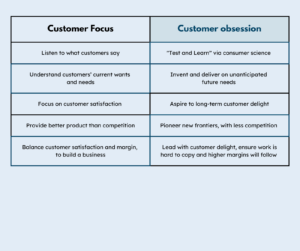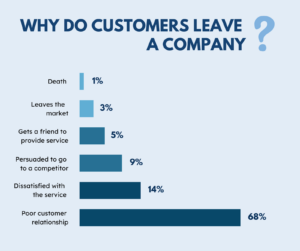“Over 4 million businesses starting every year – technology advancing at an accelerated rate, redefining the industry with each new innovation – marketing at it’s best practices”
The customer is presented with an array of diverse options – which option will turn to the CHOICE? This is the influence that a customer holds over a business today.

This blog will cover:
– What is Customer Obsession?
– Customer Centricity VS Customer Obsession
– 3 strategies on getting started with customer first mindset within an organisation
– Qualities of being customer obsessed
– 7 habits of customer obsessed companies. How well do you contribute?
– Why consider implementing a Customer Obsessed approach?
What is Customer Obsession?
Businesses give much focus on how they can develop a product or service to compete with competitors which is known as competitor obsessed. But what if the approach is about embedding customer’s perspectives into every aspect of the business from product development to the interactions and service delivery?
Customer obsession is a strategy that places the customer at the center of the business model – in other words, instead of being a part of the equation, the customer should be the answer.
Providing customer service, addressing issues and selling services that best feed their behaviour are the basic level. Customer obsession takes the hurdle of a full scale shift that will show an impact on the decision making of the organisation as a whole.
To exceed a customer’s expectations, it is essential to have a deeper understanding of the customer persona at an intrinsic level, anticipate their needs, and build a holistic approach that integrates all facets of the business—from strategy and operations to culture and measurements—toward the goal of building emotional customer connections that drive long-term loyalty and sustainable growth.
Customer Centricity VS Customer Obsession
Here is how Netflix differentiates the two terms,

The primary difference between the two terms is the level of focus they give to the customer. A customer centric approach weighs a heavy focus on satisfying the clients final product or service, whereas a customer obsession approach will revolve around fostering an ongoing dialogue and taking action in real time to enhance their buying journey. In simple terms, the two approaches differ in listening and conversation.
“Customer obsession is not just about considering the needs of customers. They need to be listened to at all levels of the company, understood and taken into account in the evolution and improvement of every process, service and product.”
Nicolas Hammer, Co-founder and CEO, Goodays
Customer obsession has emerged as a recent evolution of the customer-centric approach. The emotional connection fostered by customer obsession supports in enhancing the final product which leads to winning the customer centric approach.
3 strategies on getting started with customer first mindset within an organisation
Creating a customer first mindset goes beyond focussing on buying personas and ‘contact us’. Product development, pricing structure, payment options must all be strategized differently. Tear down the silos that hamper your customer experience, bringing together customer data and omnichannel support into one platform to make customer interactions seamless.
- Inspire the whole company
Educating all departments of an organisation is the initial step for implementing a customer obsessed strategy. The leadership must go beyond communicating this customer obsessed approach – to embodying this culture, galvanising the workforce towards sharing this common goal. This empowers cross functional teams to be highly motivated to innovate and excel in delivering unparalleled customer value. The collective contribution creates the momentum that fosters a persuasive culture of excellence, which, in turn, enhances the customer experience to drive sustainable competitive advantage.
- Building the right mindset
When incorporating a customer obsessed strategy, the mindset or the DNA of an organisation requires a deep rooted belief that the customer is at the heart of a business; nurturing this culture will improve the organization’s long term health and longevity; whereas if not this approach will act as a burden to some employees. Training and development programs support embedding these values into the company culture. Empowering employees to take ownership of customer outcomes by understanding customer perspectives would be a step to begin with.
- Innovate and Iterate
Before implementing new strategies, it is necessary to gain a clear understanding through customer surveys, feedback and data analytic metrics such as Customer Lifetime Value (CLV), Net Promoter Score (NPS) and Customer Satisfaction Score (CSAT) to achieve insights into customer relationships on the current situation of the organisation. Basing, on the given information, develop a customer centric vision and strategy which ranges from short term goals to long term roadmaps with the right metrics.
In all of this, consistency is the key to achieving all over the period of time.
Qualities of been customer obsessed
- Empathy
- Respect
- Simplicity
- Communication
- Customer focus
7 habits of customer obsessed companies. How well do you contribute?
- Ensuring immediate customer assistance and support from real individuals over AI chatbots.
- Prioritise attention on every detail of the customer journey map- which areas should be improved or changed?
- Actively engage with customers, rather than remaining behind the desks.
- Nurture the organisation culture through consistent internal communication.
- Emphasise customer quality over quantity in strategic decision making.
- Continuous tracking for progression.
- Incorporate customer satisfaction metrics into employee compensation and bonus structures.
Why consider implementing a Customer Obsessed approach?
According to Forrester, customer obsession will bring you at least 700% ROI over the span of 12 years.
Decision makers at B2B companies chose “improved our brand reputation” and “increased the percentage of customers who say positive things about us” as the top two benefits of improving customer focus according to Forrester.
The statement argues that customer focus supports brand reputation.
A study conducted by Super Office on ‘Why Do Customers Leave a Company?’ resulted in 68% of respondents stating that they believed the company did not care about them.

For global giants such as Tesla, Apple, Netflix and Starbucks – a customer obsessed culture and proactive customer service has been the driving force for success.
Customer obsession has been Amazon’s number one principle.
Amazon did not achieve success by theoretically overlooking customer desires but they excel by offering tailored recommendations and crafting individualised experiences for each customer.
However, big or small – to get started, know who your customer is and create stories that resonate with them. Moving forward, don’t forget to listen and keep listening.
Amazon, a global leader, initially started as an online bookstore and its status today has grown to a global retail giant. Founder, Jeff Bezos said,
“We’ve had three big ideas at Amazon that we’ve stuck with for 18 years, and they’re the reason we’re successful: Put the customer first, invent, and be patient.” The most important thing: Focus obsessively on the customer.”
Steve Jobs, the Founder and Former CEO of Apple said,
“You’ve got to start with the customer experience and work backwards to the technology”
The customer has always been the driving force for their massive success.
Learn more on how other companies adapt customer obsession strategies successfully.
Conclusion
The scenario of selecting between winning over a competitor and satisfying a customer highlights the gap between the ideal and the real goal of a business. Which direction will you venture in achieving your business objectives?

